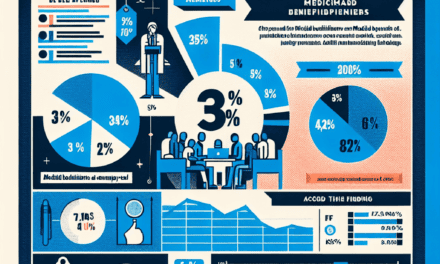Major Medicaid Reductions Ahead Following Trump’s Domestic Policy Bill Signing
The landscape of healthcare in the United States is ever-evolving, and recent developments have sparked significant concern among advocates, policymakers, and millions of Americans who rely on Medicaid for their health coverage. Following the signing of a domestic policy bill by former President Donald Trump, major reductions in Medicaid funding are anticipated. This article delves into the implications of these reductions, exploring the potential impact on beneficiaries, state budgets, and the overall healthcare system.
Understanding Medicaid: A Brief Overview
Medicaid is a joint federal and state program that provides health coverage to low-income individuals and families. Established in 1965, it has become a critical safety net for millions of Americans, covering a wide range of services, including hospital visits, long-term care, and preventive services. The program is particularly vital for vulnerable populations, including children, the elderly, and individuals with disabilities.
As of 2021, Medicaid covered over 80 million Americans, accounting for approximately 17% of the U.S. population. The program is funded through a combination of federal and state funds, with the federal government matching state spending at varying rates depending on the state’s income level. This partnership allows states to tailor their Medicaid programs to meet the specific needs of their populations.
The Domestic Policy Bill: Key Provisions and Implications
The domestic policy bill signed by Trump includes several provisions aimed at reducing federal spending, with significant implications for Medicaid funding. The bill proposes cuts to various social programs, including Medicaid, which could lead to reduced benefits and increased costs for beneficiaries.
Key provisions of the bill include:
- Funding Reductions: The bill outlines specific percentage cuts to federal Medicaid funding, which states will have to absorb.
- Eligibility Changes: Proposed changes to eligibility criteria may result in millions losing their coverage.
- Block Grants: The introduction of block grants for Medicaid funding could limit states’ flexibility in managing their programs.
- Work Requirements: The bill encourages states to implement work requirements for Medicaid beneficiaries, potentially disqualifying those unable to meet these requirements.
- Increased State Responsibilities: States may be required to shoulder a larger share of Medicaid costs, straining already tight budgets.
These provisions have raised alarms among healthcare advocates, who argue that such cuts will disproportionately affect the most vulnerable populations, leading to increased health disparities and negative health outcomes.
Impact on Beneficiaries: Who Will Be Affected?
The proposed Medicaid reductions are expected to have a profound impact on beneficiaries, particularly those who rely on the program for essential health services. The potential consequences of these cuts include:
- Loss of Coverage: Millions of low-income individuals and families may lose their Medicaid coverage due to stricter eligibility requirements and funding cuts.
- Reduced Access to Services: Beneficiaries may face limited access to necessary medical services, including preventive care, mental health services, and long-term care.
- Increased Out-of-Pocket Costs: With reduced funding, states may shift costs to beneficiaries, leading to higher premiums, deductibles, and copayments.
- Health Disparities: Vulnerable populations, including racial and ethnic minorities, may experience worsening health outcomes as access to care diminishes.
- Increased Emergency Room Visits: As access to primary care decreases, beneficiaries may resort to emergency rooms for care, leading to higher healthcare costs overall.
For example, a study by the Kaiser Family Foundation found that states that expanded Medicaid under the Affordable Care Act saw significant reductions in uninsured rates and improved health outcomes. Conversely, states that implemented cuts or restrictions experienced increased rates of uninsurance and poorer health metrics.
State Budgets: The Financial Ramifications
The financial implications of Medicaid reductions extend beyond individual beneficiaries; they also pose significant challenges for state budgets. States are already grappling with tight budgets, and the proposed cuts could exacerbate existing financial pressures.
Key financial ramifications include:
- Increased State Spending: States may need to allocate more funds to cover the shortfall created by federal cuts, diverting resources from other essential services.
- Budget Shortfalls: Reduced federal funding could lead to budget shortfalls, forcing states to make difficult decisions about program funding and service delivery.
- Impact on Local Economies: Medicaid cuts can have ripple effects on local economies, particularly in rural areas where healthcare providers rely heavily on Medicaid reimbursements.
- Job Losses in Healthcare: As funding decreases, healthcare providers may face financial strain, leading to potential layoffs and reduced hiring in the sector.
- Increased Pressure on Other Programs: Cuts to Medicaid may increase demand for other social services, such as food assistance and housing support, further straining state budgets.
For instance, a report from the National Association of State Budget Officers indicated that states are already facing significant budgetary challenges due to the COVID-19 pandemic. The additional burden of Medicaid cuts could lead to further fiscal instability, impacting a wide range of public services.
Healthcare Providers: Challenges and Responses
The proposed Medicaid reductions will also have significant implications for healthcare providers, particularly those serving low-income populations. As funding decreases, providers may face challenges in maintaining the quality and availability of care.
Key challenges for healthcare providers include:
- Reimbursement Rate Cuts: Reduced federal funding may lead to cuts in Medicaid reimbursement rates, making it difficult for providers to cover their costs.
- Increased Administrative Burden: Changes in eligibility and funding structures may create additional administrative challenges for providers, diverting resources away from patient care.
- Provider Shortages: As financial pressures mount, some providers may choose to limit or discontinue Medicaid services, exacerbating access issues for beneficiaries.
- Impact on Quality of Care: Financial strain may lead to reduced staffing levels and resources, potentially compromising the quality of care provided to Medicaid beneficiaries.
- Innovative Responses: Some providers may seek innovative solutions, such as telehealth services or community partnerships, to adapt to the changing landscape.
For example, a study published in the Journal of Health Economics found that Medicaid reimbursement rates significantly influence provider participation in the program. Lower rates can lead to decreased access for beneficiaries, particularly in underserved areas.
Advocacy and Future Directions: Navigating the Changes
In light of the anticipated Medicaid reductions, advocacy efforts are crucial to protect the interests of beneficiaries and ensure access to essential healthcare services. Various stakeholders, including healthcare organizations, advocacy groups, and policymakers, are mobilizing to address the challenges posed by the proposed cuts.
Key advocacy strategies include:
- Public Awareness Campaigns: Raising awareness about the potential impact of Medicaid cuts on vulnerable populations can galvanize public support for preserving funding.
- Engaging Policymakers: Advocates are working to engage policymakers at both the state and federal levels to highlight the importance of Medicaid and the need for continued funding.
- Coalition Building: Forming coalitions among healthcare providers, advocacy organizations, and community groups can strengthen efforts to protect Medicaid funding.
- Legal Challenges: In some cases, legal challenges may be pursued to contest cuts or changes to Medicaid that violate existing laws or regulations.
- Exploring Alternative Funding Models: Advocates are exploring alternative funding models that could provide more stable and equitable funding for Medicaid programs.
For instance, organizations like the National Health Law Program and the Center on Budget and Policy Priorities are actively working to protect Medicaid funding through research, advocacy, and legal action. Their efforts underscore the importance of a robust safety net for low-income individuals and families.
Conclusion: The Road Ahead for Medicaid
The anticipated Medicaid reductions following Trump’s domestic policy bill signing represent a significant challenge for millions of Americans who rely on the program for their health coverage. The potential loss of coverage, increased costs, and strain on state budgets could have far-reaching consequences for beneficiaries, healthcare providers, and the overall healthcare system.
As advocates and stakeholders mobilize to address these challenges, it is essential to recognize the critical role that Medicaid plays in ensuring access to healthcare for vulnerable populations. The road ahead will require concerted efforts to protect and preserve this vital program, ensuring that all Americans have access to the care they need.
In summary, the implications of Medicaid reductions are profound and multifaceted, affecting not only individual beneficiaries but also state budgets, healthcare providers, and the broader healthcare landscape. As the situation unfolds, ongoing advocacy and engagement will be crucial in navigating the changes and safeguarding the future of Medicaid.




